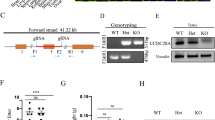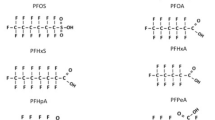Abstract
Fluoride (F) is an essential trace element that humans and animals ingest from water, air, and fluoride-containing products; however, excessive fluoride absorption can damage a variety of organs and tissues, including the male reproductive system. Our previous studies found that fluoride exposure lowered sperm quality and interfered with spermatogenesis; however, the exact mechanism remained unclear. Proteins cytochrome P450 (P450), cAMP-responsive element modulator (CREM), and activator of CREM in testis (ACT) play the key roles in spermatogenesis and sperm motility. To investigate whether fluoride affects the expression of P450, CREM, and ACT, we used immunohistochemical techniques to determine expression levels of these proteins in testes of rats administered 100 mg NaF/L for 2 weeks via drinking water. The results showed that P450 expression was decreased while CREM and ACT expression was increased in the fluoride group, compared to the control. These data suggest that fluoride can impair male reproduction by affecting expression of P450, CREM, and ACT in the testes.



Similar content being viewed by others
References
Agalakova NI, Gusev G.P. (2012) Molecular mechanisms of cytotoxicity and apoptosis induced by inorganic fluoride. ISRN Cell Biology:1–16
Wan SX, Zhang JH, Wang JD (2006) Effects of high fluoride on sperm quality and testicular histology in male rats. Fluoride 39(1):17–21
Zhang S, Jiang C, Liu H et al (2013) Fluoride-elicited developmental testicular toxicity in rats: roles of endoplasmic reticulum stress and inflammatory response. Toxicol Appl Pharmacol 271(2):206–215
Yan XY, Hao XH, Nie QL et al (2015) Effects of fluoride on the ultrastructure and expression of Type I collagen in rat hard tissue. Chemosphere 128:36–41
Zhou B, Zhao J, Liu J et al (2015) Fluoride-induced oxidative stress is involved in the morphological damage and dysfunction of liver in female mice. Chemosphere 139:504–511
Xu H, Hu LS, Chang M et al (2005) Proteomic analysis of kidney in fluoride-treated rat. Toxicol Lett 160(1):69–75
Niu RY, Liu SL, Wang JM et al (2014) Proteomic analysis of hippocampus in offspring male mice exposed to fluoride and lead. Biol Trace Elem Res 162(1–3):227–233
GeY NR, Zhang J et al (2011) Proteomic analysis of brain proteins of rats exposed to high fluoride and low iodine. Arch Toxicol 85(1):27–33
Zhou BH, Wang HW, Wang JM et al (2007) Effects of malnutrition and supplemented nutrition on non-specific immune function changes induced by fluoride in rabbits. Fluoride 40(3):169–177
Barbier O, Arreola-Mendoza L, Del Razo LM (2010) Molecular mechanisms of fluoride toxicity. Chem Biol Interact 188:319–333
Long H, Jin Y, Lin M et al (2009) Fluoride toxicity in the male reproductive system. Fluoride 42(3):260–276
Zhang JH, Liang C, Ma JJ et al (2006) Effects of sodium fluoride and sulfur dioxide on sperm motility and serum testosterone in male rats. Fluoride 39(2):126–131
Wan SX, Zhang JH, Wang JD (2006) Fluoride-induced changes in the expression of epidermal growth factor and its receptor in testicular tissues of young male rats. Fluoride 39(2):121–125
Sun ZL, Zhang W, Xue XC et al (2016) Fluoride decreased the sperm ATP of mice through inhabiting mitochondrial respiration. Chemosphere 144:1012–1017
Lu ZJ, Wang SL, Sun ZL et al (2014) In vivo influence of sodium fluoride on sperm chemotaxis in male mice. Arch Toxicol 88:533–539
Han HJ, Sun ZL, Luo GY et al (2015) Fluoride exposure changed the structure and the expressions of reproductive related genes in the hypothalamus-pituitary-testicular axis of male mice. Chemosphere 135:297–303
Cheshenko K, Pakdel F, Segner H et al (2008) Interference of endocrine disrupting chemicals with aromatase CYP19 expression or activity, and consequences for reproduction of teleost fish. Gen Comp Endocrinol 155:31–62
Hinfray N, Porcher JM, Brion F (2006) Inhibition of rainbow trout (Oncorhynchus mykiss) P450 aromatase activities in brain and ovarian microsomes by various environmental substances. Comp Biochem Physiol C: Toxicol Pharmacol 144:252–262
Sassone-Corsi P (2000) CREM: a master-switch regulating the balance between differentiation and apoptosis in male germ cells. Mol Reprod Dev 56:228–229
Kotaja N, Macho B, Sassone-Corsi P (2005) Microtubule-independent and protein kinase A-mediated function of kinesin KIF17b controls the intracellular transport of activator of CREM in testis (ACT). J Biol Chem 280:31739–31745
Olivier B, Laura AM, Del Razo LM (2010) Molecular mechanisms of fluoride toxicity. Chem Biol Interact 188(2):319–333
Ortiz-Perez D, Rodríguez-Martínez M, Martínez F et al (2003) Fluoride-induced disruption of reproductive hormones in men. Environ Res 93:20–30
Danielson PB (2002) The cytochrome P450 superfamily: biochemistry, evolution and drug metabolism in humans. Curr Drug Metab 3:561–597
Miller W (1988) Molecular biology of steroid hormone synthesis. Endocr Rev 9:295–318
Ijiri S, Takei N, Kazeto Y (2006) Changes in localization of cytochrome P450 cholesterol side-chain cleavage (P450scc) in Japanese eel testis and ovary during gonadal development. Gen Comp Endocrinol 145:75–83
Hinfray N, Baudiffier D, Marcelo C et al (2011) Characterization of testicular expression of P450 17α-hydroxylase, 17,20-lyase in zebrafish and its perturbation by the pharmaceutical fungicide clotrimazole. Gen Comp Endocrinol 174:309–317
Carpino A, Pezzi V, Rago V et al (2001) Immunolocalization of cytochrome P450 aromatase in rat testis during postnatal development. Tissue Cell 33(4):349–353
Nantel F, Monaco L, Foulkes NS (1996) Spermiogenesis deficiency and germ-cell apoptosis in CREM-mutant mice. Nature 380:159
Krausz C, Sassone-Corsi P (2005) Genetic control of spermiogenesis: insights from the CREM gene and implications for human infertility. Reprod Biomnd Online 10:64–71
Fimia GM, De Cesare D, Sassone-Corsi P (1999) CBP-independent activation of CREM and CREB by the LIM-only protein ACT. Nature 398:165–169
Yu YE, Yun Z, Emmanual U et al (2000) Abnormal spermatogenesis and reduced fertility in transition nuclear protein 1-deficient mice. PNAS 97:4683–4688
Dadoune JP (2003) Expression of mammalian spermatozoal nucleo-proteins. Microsc Res Tech 61:56–75
Beißbarth T, Borisevich I, Hörlein A (2003) Analysis of CREM-dependent gene expression during mouse spermatogenesis. Mol Cell Endocrinol 212:29–39
Kotaja N, De Cesare D, Macho B et al (2004) Abnormal sperm in mice with targeted deletion of the act (activator of Camp-responsive element modulator in testis) gene. PNAS 101:10620–10625
Acknowledgments
This research was supported by the China National Natural Science Foundation (Grant No. 30901092, 31172380), Specialized Research Fund for the Doctoral Program of Higher Education of China (20091403120002), Science and Technology Program of Shanxi Province (20130311028–4), Program for Top Young Academic Leaders of Higher Institutions of Shanxi (201001), and Program for Innovation of Outstanding Graduate in Shanxi Province (2014057).
Author information
Authors and Affiliations
Corresponding authors
Ethics declarations
All regulations of the Institutional Animal Care and Use Committee of Shanxi Agricultural University were strictly followed during the experiment to protect the welfare of the animals.
Conflict of interest
The authors declare that they have no conflicts of interest.
Rights and permissions
About this article
Cite this article
Zhang, J., Zhu, Y., Liang, C. et al. Effects of Fluoride on Expression of P450, CREM and ACT Proteins in Rat Testes. Biol Trace Elem Res 175, 156–160 (2017). https://doi.org/10.1007/s12011-016-0753-9
Received:
Accepted:
Published:
Issue Date:
DOI: https://doi.org/10.1007/s12011-016-0753-9




